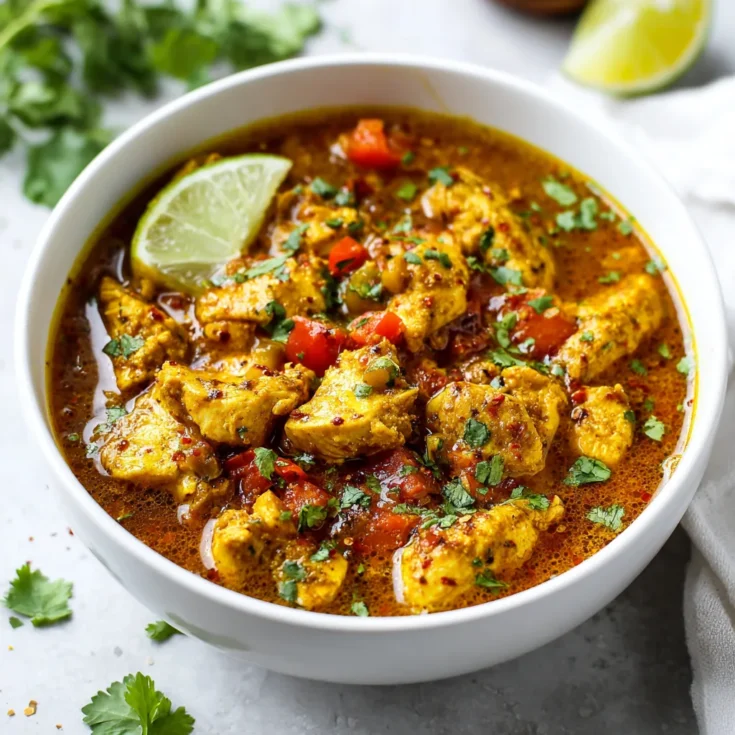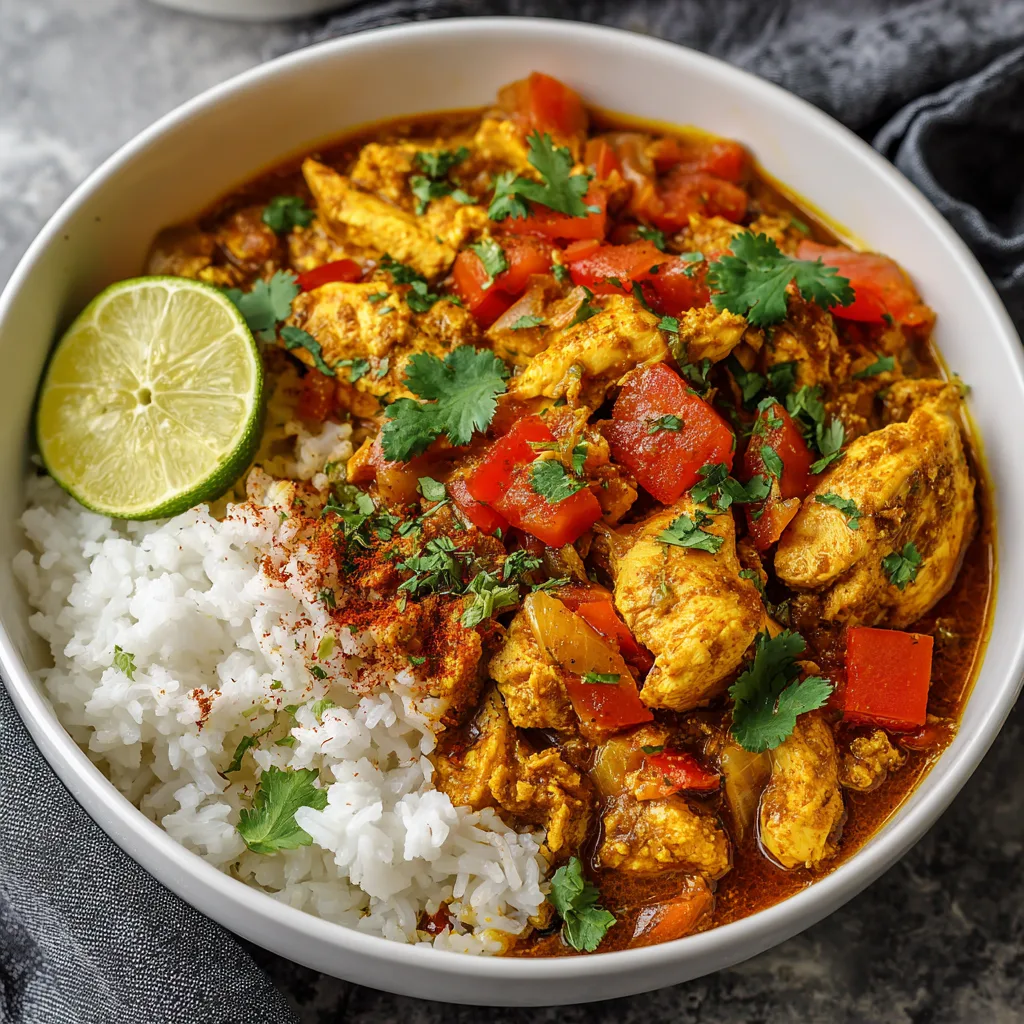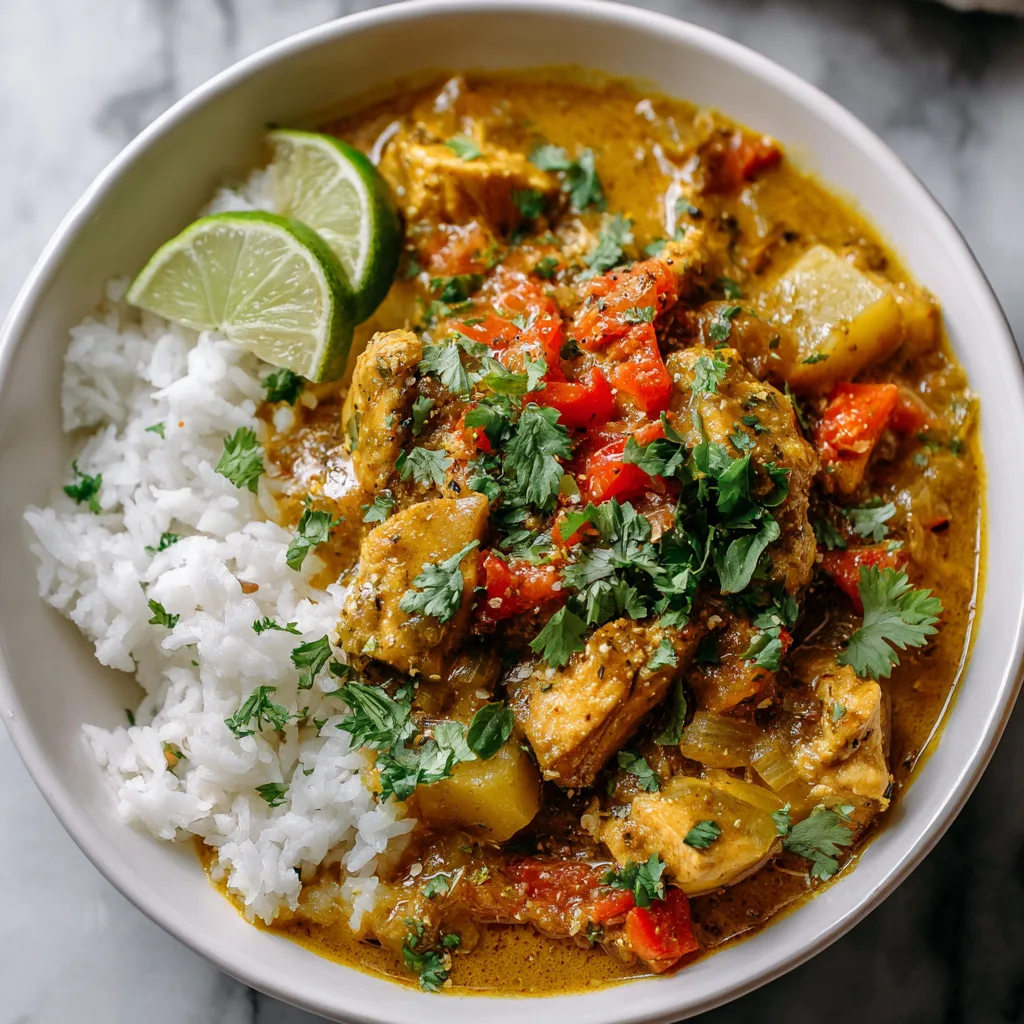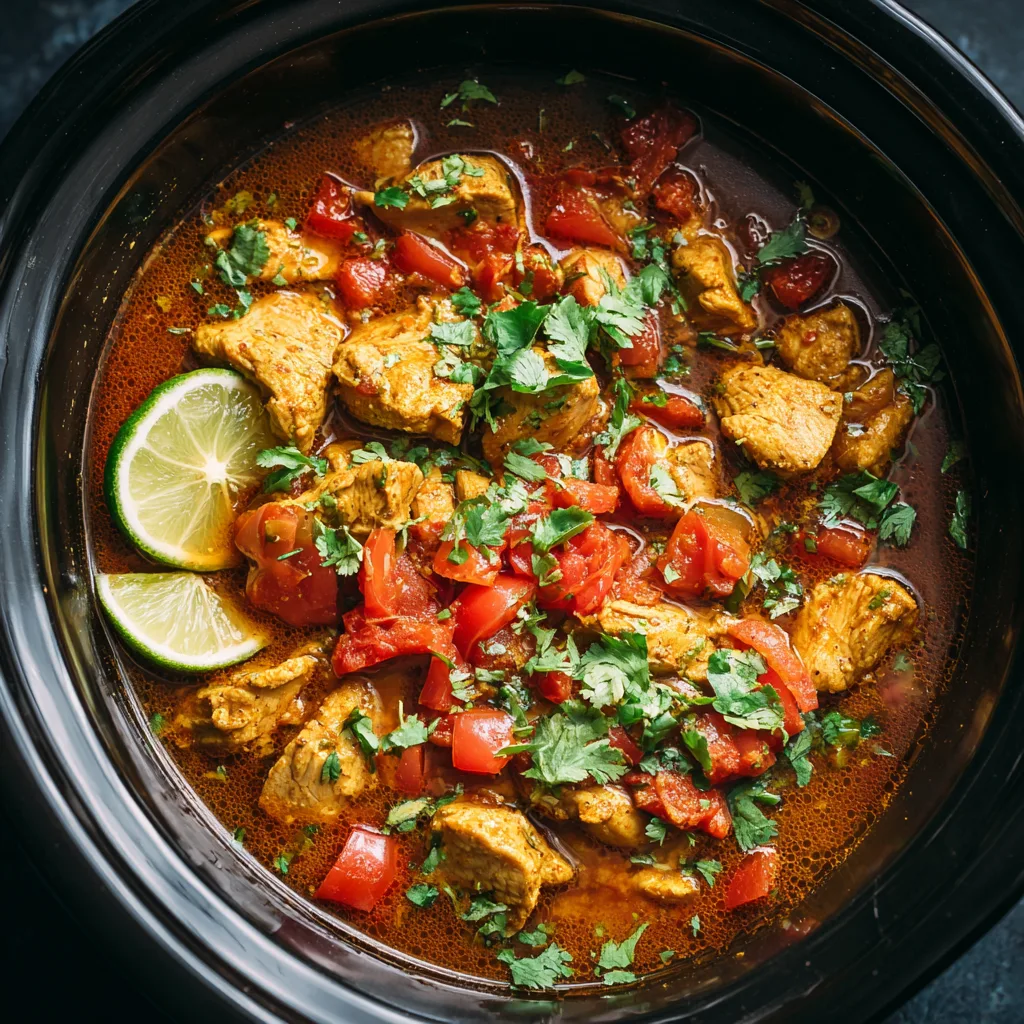Looking for a meal that’s hearty, healthy, and hassle-free? High protein crockpot chicken curry brings together bold flavors, lean meats, and slow-cooked tenderness in one comforting dish. Whether you’re trying to eat cleaner, bulk up your protein intake, or feed a busy household, this recipe delivers on all fronts.
At its core, this dish is high in protein thanks to its generous use of lean chicken. Chicken breast is especially rich in protein while being low in fat, making it a smart choice for those aiming to build muscle or stay full longer. Even chicken thighs—slightly higher in fat—offer deep flavor and satisfying texture without compromising nutrition.
What truly elevates this curry is the use of a Crockpot. Slow cooking allows the spices to fully bloom and the chicken to stay tender and juicy. You get bold, comforting curry flavor with almost zero effort—just set it and forget it.
Who This Dish Is For
This high-protein chicken curry is ideal for fitness enthusiasts who track macros, busy families needing a no-fuss dinner, and anyone who wants a meal-prep staple that reheats like a dream. It’s naturally gluten-free and can be made dairy-free with coconut milk. Whether you’re cutting carbs, avoiding allergens, or just want something nourishing, this curry fits your lifestyle.
Choosing the Right Chicken for High Protein Curry
Selecting the best cut of chicken is key to maximizing both flavor and protein. Chicken breasts are lean, affordable, and packed with protein—about 26 grams per 3-ounce serving. They’re ideal if you’re aiming for a low-fat, high-protein diet. Their mild flavor absorbs spices well, making them a natural fit for curry.
Chicken thighs offer a slightly richer taste and more tender texture due to their higher fat content. While they contain a bit less protein—around 22 grams per 3-ounce portion—they’re often more forgiving in slow cookers and stay juicy longer. For budget-conscious cooks, thighs also tend to be more affordable.
Whether you prefer breast or thigh, both cuts contribute significantly to your daily protein goals. When slow-cooked, each cut becomes incredibly tender, blending seamlessly into the rich sauce.
Protein Boosting Add-Ins for Extra Nutrition
To elevate the protein content further, consider adding simple, nutrient-dense ingredients. Greek yogurt is a smart choice. It not only adds creaminess and tang, but also delivers a high dose of protein without excess fat. Coconut milk, while lower in protein, brings a silky texture and rich flavor that balances spicy curry perfectly.
You can also stir in legumes like lentils or chickpeas. These plant-based powerhouses increase protein and fiber, helping you stay fuller longer. For comparison, ½ cup of cooked lentils adds about 9 grams of protein.
Each add-in has its benefits. Greek yogurt boosts protein while maintaining a thick texture. Coconut milk makes the dish dairy-free and comforting. Legumes transform the curry into a complete one-pot meal.
Essential Spices and Bold Curry Flavors
No chicken curry is complete without the right blend of spices. Start with curry powder—a staple that brings warmth and complexity. Add turmeric for its golden color and anti-inflammatory benefits. Garlic and ginger give your curry that essential zing and depth.
For a bolder twist, stir in Thai red curry paste. It intensifies heat and aroma, giving your curry an exotic edge. Just a spoonful can transform the entire dish.
To finish, consider thickening the sauce with a cornstarch slurry or plain yogurt. Both methods add body to the sauce without overpowering the flavors. If using yogurt, temper it first to avoid curdling.
Together, these ingredients create a rich, balanced, and high-protein curry that’s as nourishing as it is flavorful.
Regional & Flavor Twists on Chicken Curry
Chicken curry is endlessly adaptable, with regional variations that bring exciting flavor profiles. If you’re drawn to traditional Indian-style curry, opt for a tomato-based sauce or a creamy coconut milk base. Tomatoes offer acidity and brightness, while coconut creates a smooth, mellow richness. Both pair well with bold spices like cumin, garam masala, and coriander.
For a Thai-inspired twist, red curry paste and fish sauce bring depth and umami. Thai red curry typically features coconut milk, bell peppers, and a squeeze of lime juice to brighten the flavors. This version tends to be slightly sweeter and more aromatic than Indian curry.
Want something more unique? Try a yellow curry variation made with peanut butter. It sounds unconventional, but the combination of warm spices and creamy peanuts creates a nutty, comforting sauce. It also adds healthy fats and extra protein, making it perfect for a heartier version.
Whether you prefer bold heat or mellow warmth, there’s a regional twist to suit your taste.
Dietary Swaps & Smart Substitutes
This recipe is naturally flexible, so it’s easy to customize for dietary needs. For a dairy-free version, swap Greek yogurt with unsweetened coconut yogurt. It delivers the same creamy texture without any dairy content. Prefer a lower-fat dish? Use light coconut milk or a reduced-fat yogurt alternative.
To keep it gluten-free, make sure your curry paste and broth are certified gluten-free. Most natural ingredients used in curry are already safe, but it’s best to check labels for hidden additives.
Vegetarian? No problem. Replace the chicken with canned chickpeas, lentils, or cubed tofu. These options soak up flavor beautifully and keep the protein levels high. Chickpeas, in particular, add both texture and heartiness.
These swaps make the curry inclusive and nourishing for a wide range of diets.
Make-Ahead & Storage Tips
One of the best things about crockpot chicken curry is how well it stores. After cooking, let the curry cool to room temperature. Then store it in airtight containers in the fridge for up to four days.
For longer storage, freeze individual portions for up to three months. Reheat gently on the stove or in the microwave, adding a splash of broth if needed to loosen the sauce.
This dish also tastes even better the next day, as the flavors continue to develop. It’s an ideal choice for meal prep and busy weeks.
Prep & Setup for Crockpot Chicken Curry
Preparation is simple but makes a big difference. Start by dicing your onion, mincing garlic, and grating fresh ginger. Cut the chicken into evenly sized chunks for consistent cooking. Use skinless, boneless chicken breast or thighs, depending on your texture and flavor preference.
If you want deeper flavor, sear the chicken pieces in a hot skillet with a touch of oil before transferring them to the slow cooker. Browning creates a richer, more layered curry. However, if time is tight, the dump-and-go method still delivers excellent results. Just toss all the ingredients directly into the Crockpot and stir.
Next, add your curry powder, turmeric, salt, and pepper. For extra depth, include optional ingredients like red curry paste or chili flakes. Finally, pour in coconut milk or broth. Stir well to coat everything in flavor before sealing the lid.
Cooking Process for Maximum Flavor
Set your slow cooker to LOW for 4 to 5 hours or HIGH for 2½ to 3 hours. Low heat yields juicier, more tender chicken, while high heat is ideal when you’re short on time. Either method works, but don’t go beyond recommended times to avoid overcooking.
Add sturdy vegetables—like carrots or bell peppers—midway through the cooking process so they don’t turn mushy. This keeps the texture vibrant and the dish balanced.
If you’re using Greek yogurt instead of coconut milk, stir it in during the last 20 to 30 minutes of cooking. For best results, temper the yogurt by mixing it with a few spoonfuls of hot liquid from the Crockpot first. This helps it blend smoothly without curdling.
To thicken the sauce near the end, make a slurry with cornstarch and water, then stir it in and let the curry cook uncovered for 10 to 15 minutes.
Serving Suggestions & Perfect Pairings
This curry pairs beautifully with a variety of sides. For a classic option, serve it over fluffy white rice or nutty brown rice. Looking for a grain alternative? Quinoa adds extra protein, while cauliflower rice keeps things low-carb and light.
Scoop up every bit of the rich sauce with warm naan or gluten-free flatbread. You can also ladle the curry over baked sweet potatoes for a filling twist.
Top it off with fresh cilantro, a squeeze of lime, and a sprinkle of chopped peanuts. These garnishes add brightness, crunch, and a restaurant-style finish that elevates every bowl.
Troubleshooting Common Issues in Crockpot Curry
Sauce Too Watery?
Crockpots naturally trap moisture, which can result in a thin sauce. If that happens, don’t worry. Stir in a cornstarch slurry (1 tablespoon cornstarch + 2 tablespoons water), and let it simmer uncovered for 15 minutes. You’ll get a thick, velvety curry that clings perfectly to each bite of chicken.
If you’re using yogurt, you can also allow it to simmer uncovered after adding it to naturally reduce and thicken the sauce.
Overcooked Chicken?
Overcooking is a common issue in slow cookers, especially with chicken breasts. They can dry out if left too long on high heat. To prevent this, always set a timer and choose the low setting when possible. Chicken thighs are more forgiving and stay moist even after extended cooking.
For the best texture, aim for tender, not falling apart. If the chicken begins to shred too early, reduce the heat or switch the cooker off and let the curry rest. This keeps the dish from turning overly soft or grainy.
By managing time and temperature carefully, you ensure your chicken curry stays rich, satisfying, and perfectly textured every time.
Frequently Asked Questions About High Protein Crockpot Chicken Curry
Can I use raw chicken in the Crockpot?
Yes, you can safely use raw chicken in your slow cooker. As long as the internal temperature reaches 165°F, the chicken will cook thoroughly and remain juicy. Just layer it with your spices and liquids, then let the Crockpot do the work.
Is it better to brown chicken first?
Browning chicken before slow cooking is optional, but it can add depth and a richer flavor. The caramelization from searing helps enhance the final taste and texture. However, for a faster prep, skipping this step still yields a delicious curry.
Can I make this in an Instant Pot?
Absolutely. To adapt this recipe for an Instant Pot, use the sauté function to brown the onions and chicken first. Then cook on high pressure for 8 minutes with a natural release of about 10 minutes. This method offers the same great flavor in less time.
Why is my curry watery?
Crockpots create a sealed environment, so liquids don’t evaporate like they do on the stove. If your curry ends up too watery, stir in a cornstarch slurry and cook uncovered for 10 to 15 minutes. You can also use yogurt at the end for a naturally thicker consistency.
How long does it last in the fridge or freezer?
This chicken curry stores beautifully. In the refrigerator, it will stay fresh for 3 to 4 days when sealed properly. For longer storage, freeze it in individual portions for up to 3 months. Reheat gently to preserve the texture and flavor.
High Protein Crockpot Chicken Curry – Easy, Flavorful, and Meal-Prep Friendly

This high protein crockpot chicken curry is the perfect blend of flavor and nutrition. It’s packed with lean chicken, infused with bold spices, and simmered slowly to create a comforting, satisfying meal. Whether you use coconut milk or Greek yogurt, this curry is creamy, hearty, and ideal for meal prep.
Ingredients
- 1.5 lb boneless skinless chicken breasts or thighs, cut into chunks
- 1 large onion, diced
- 3 cloves garlic, minced
- 1 tablespoon fresh ginger, grated
- 2 tablespoons curry powder (or curry paste)
- 1 teaspoon turmeric
- 1 teaspoon salt
- ½ teaspoon black pepper
- 1 can (14 oz) lite coconut milk or 1 cup plain Greek yogurt
- ½ cup chicken broth
- 2 tablespoons cornstarch (optional, for thickening)
- Optional: 1 bell pepper, 2 carrots, chopped cilantro, lime juice
Instructions
Notes




